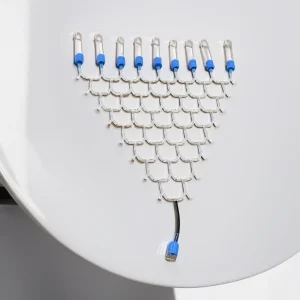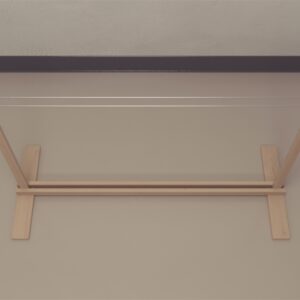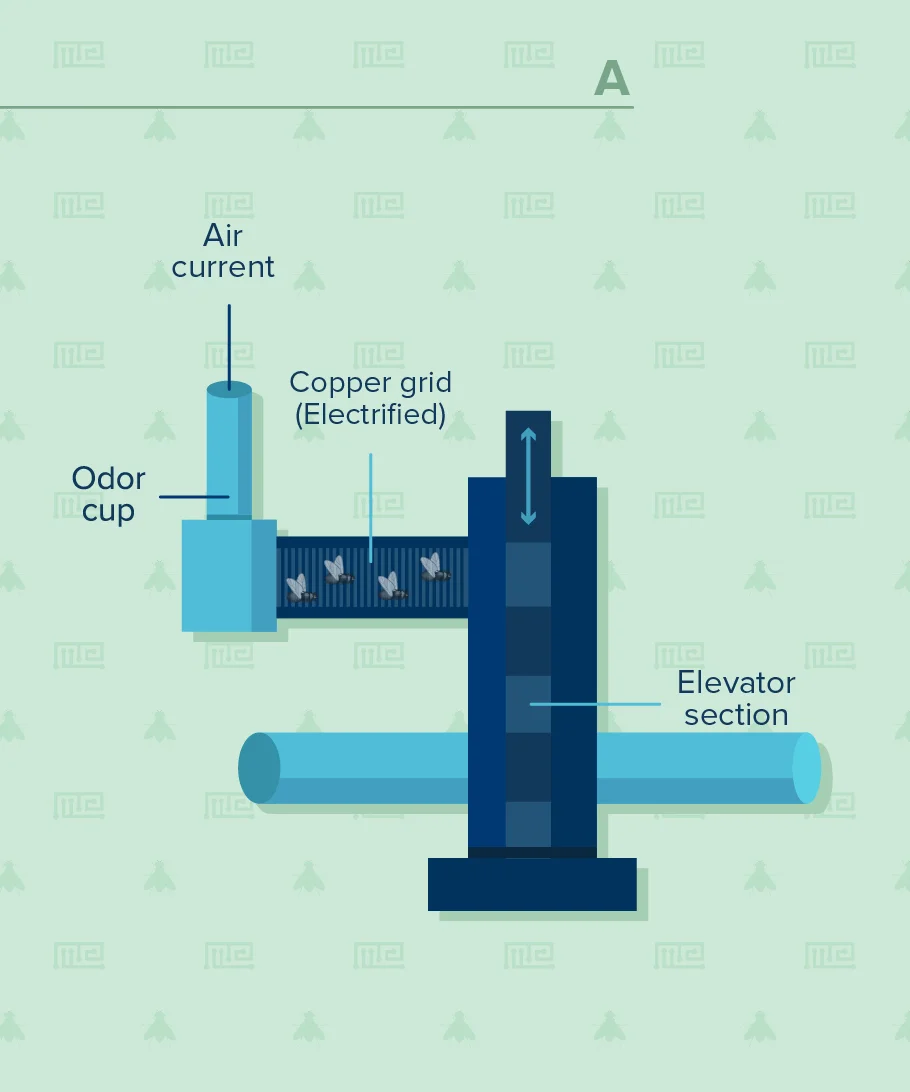$4,900.00
The Drosophila odor-aversion learning setup was pioneered by Tully and Quinn (1985), employing a T maze and electric shocks delivered through a copper wire grid. MazeEngineers offers an enhanced version featuring a durable, transparent apparatus with designated holding and choice areas leading to odor compartments. To facilitate odor diffusion, two vacuum seal lines generate negative pressure. Electrifying the copper training tube is effortless with the provided plug. Additionally, each order includes a clamp to minimize odor leakage during testing. Please note, odors are not provided.

MazeEngineers empowers preclinical neuroscience research with meticulously designed, customizable behavioral apparatuses. From manual classic mazes to fully automated smart systems, we provide the tools scientists need to capture high-quality, reproducible data for studies on learning, memory, anxiety, and depression.

bool(false)

bool(false)

Features |
2 Odor chambers |
T maze choice area |
Copper testing tube |
Vacuum lines |
Secure clamp |



Tully and Quinn (1985) laid the groundwork for olfactory aversive conditioning in Drosophila. Typically, this involves a binary T-maze choice where flies learn to associate an odor with an electric shock in a training tube.
Various assessments of learning and memory can be conducted. Immediate evaluation of learning occurs post-training, while short-term memory is assessed 30 minutes to 1 hour later, and mid-term memory is evaluated at 3 hours post-training. Memory’s labile phase from a single training cycle can persist up to 7 hours. Moreover, repetitive training cycles with intervals induce long-term memory lasting up to a week, while continuous training without intervals forms anesthesia-resistant memory, akin to long-term memory.
Tests are conducted under dim-red light or darkness to allow fly visualization while preventing experimenter visibility. Opaque cylindrical tubes connected to a T-maze, with an attached air pump for odor diffusion, are essential. An airtight seal ensures proper functionality. Shocks are induced by an electrifiable grid, controlled by the investigator for onset, intensity, and duration.
The experimental protocol involves fly adaptation to the tube and airflow, exposure to the first odor paired with a shock, followed by the second odor with no shock. A rest period precedes testing for learning assessment. Flies choose between tubes containing test odors. For memory assessment, flies are kept in the dark at lower temperatures until testing.
Drosophila serves as an invaluable model for neurobehavioral assessments, offering opportunities for genetic, behavioral, dietary, and pharmacological manipulations. Its advantages include low maintenance costs for large sample sizes, small size facilitating longitudinal studies, and the ability to explore discrete neural pathways and structures (Buchanan et al., 2015).
Click the image to zoom in
Note: Vacuum lines are connected to the upper port (on the sliding doors) during training and the the lower port during trial .The kit does not include a vacuum but can be included upon request.
A: Training Tube: Inner surface covered with an electrifiable copper grid
B: T Maze Choice Point for testing relative odor preferences
C: Sliding Center Compartment: For transfering flies from the training tube to the choice point and odor tube
D: Odor tubes: odor cups placed here
The analysis of operant conditioning in Drosophila generally involves using opaque, open cylindrical tubes that are connected to a T-maze. It is essential to maintain an airtight seal within the compartments. The T-maze should be linked to an air pump through tubing to allow exposure to odors. An electrifiable grid is employed to administer aversive stimuli. According to Malik and Hodge (2014), copper grids should be installed inside the training tube. These grids need to be connected to a switch-box, which is then linked to an electric stimulator using crocodile clips. The experimenter must control the shock presentation, its intensity, and duration. A voltmeter can be used to verify that the apparatus delivers the necessary shock (Malik and Hodge, 2014).
For experiments involving transgene expression or activation of heat-sensitive ion channels to stimulate neurons, it’s crucial to rear the flies at a temperature range of 18-23 °C. This temperature range prevents the premature expression of transgenes or maintains the ion channels in an inactive state. Testing should be conducted at a higher temperature, ideally between 30-33 ºC (Malik and Hodge, 2014; Buchanan et al., 2015). Similar temperature considerations apply when utilizing the Shibire temperature-sensitive phenotype to inhibit synaptic output (Malik and Hodge, 2014; Buchanan et al., 2015). If there’s a delay between training and testing, it’s advisable to store the flies at 25 ºC with 70% relative humidity and maintain a 12:12 hr light-dark cycle, as recommended by Malik and Hodge (2014). Experiments should be carried out under dim-red light or in darkness to facilitate fly observation while minimizing their visibility of the investigator (Pitman et al., 2009; Malik and Hodge, 2014). This experimental protocol allows for the simultaneous testing of up to 100 flies (Pitman et al., 2009).
In the aversive conditioning of Drosophila, training commences with introducing the flies into the training tube connected to the T-maze. It’s imperative to allow the flies a minimum of 90 seconds to acclimate to the tube and the airflow dynamics (Malik and Hodge, 2014) before subjecting them to the initial simultaneous exposure to odor 1 (+) and an electric shock. Pitman et al. (2009) advocate for a 1-minute exposure to odor 1 accompanied by twelve 1-second electric shocks administered at 5-second intervals. Conversely, Malik and Hodge (2014) propose employing 60-V shocks, comprising twelve 1.25-second pulses with 3.75-second inter-pulse intervals.
Following this phase, the flies undergo a 30-second exposure to fresh air, succeeded by another 1-minute exposure to odor 2 (-) without electric shock. It’s vital to allow the flies an additional 30-second rest period before proceeding to testing.
When evaluating the performance index within a group of flies, Pitman et al. (2009) recommend training a separate population with the + and − odors reversed. The final performance index is then determined as the average of the two reciprocal half experiments.
Common odor choices for these experiments include 4-methylcyclohexanol, 3-octanol, and quinine hydrochloride (Pitman et al., 2009; van Swinderen, 2011).
For testing, Pitman (2009) suggests transferring the flies using an elevator to the T-maze, where they are given a 2-minute window to select between tubes containing either of the two odorants used during conditioning. Conversely, Malik and Hodge (2014) propose a different approach, advocating for moving the flies from the training chamber into the central chamber of the T-maze by tilting the T-maze sideways and gently tapping its base on a soft surface. Similar to training, the flies should remain in the central chamber for 90 seconds.
To assess learning, the investigator should relocate the flies to the choice point of the T-maze, allowing for simultaneous exposure to both odors. The test period, during which the investigator evaluates which side the flies choose, should last for 2 minutes. Subsequently, the flies should be collected from each arm of the T-maze and from the central compartment, transferring them into food vials for counting.
To evaluate memory, flies should be transferred to food vials devoid of yeast and stored in darkness until testing. When assessing long-term memory, Malik and Hodge (2014) recommend conducting 5 cycles of training with or without a 15-minute inter-cycle interval. During storage, the flies should be kept at 18 °C with 70% humidity in darkness. Before testing, the investigator should return the flies to 25 °C and allow them to acclimate for at least 1 hour.
Following testing, Malik and Hodge (2014) suggest cleaning odor cups using hot water and odorless detergent. Once dried, the cups should be coated with sigmacote. Additionally, T-maze tubes and odor blocks should undergo periodic cleaning with hot water and odorless detergent.
Instead of employing aversive stimuli, sucrose reward can be utilized in food-deprived flies (Tempel et al., 1983). Training and testing protocols mirror those of aversive conditioning. Compared to shocks, sucrose has been shown to result in longer memory retention (Tempel et al., 1983; Malik and Hodge, 2014). Colomb et al. (2009) demonstrated that both sugar responsiveness and short-term memory increase with starvation length before conditioning. Additionally, the authors noted that the protein dependency of long-term memory is unaffected by the repetition and spacing of training sessions, starvation duration, or the strength of the unconditioned stimulus.
Sucrose reward can also be employed to evaluate the proboscis extension reflex, as flies extend their proboscis in response to sugar presented to gustatory receptors on the foreleg tarsi. This reflex extension is contingent on sugar concentration and the presence of a bitter substance added to the sugar. Flies are starved and immobilized on slides. This paradigm can also incorporate odors as described above (Wang et al., 2004; Chabaud et al., 2006).
In lieu of shocks, analysis of operant conditioning in Drosophila can be conducted using light. Van Swinderen (2011) introduced a paradigm known as aversive phototaxic suppression, which utilizes light/dark association to evaluate visual perception. Flies learn to associate a lit chamber with an aversive stimulus (quinine hydrochloride), which remains present throughout the study. The fly’s ability to avoid phototaxis is assessed by the number of dark/light choices.
Diverse approaches can be employed to present the results of Drosophila’s olfactory aversive conditioning, depending on the parameters being studied. One method involves comparing learning across different genotypes, represented as a performance index that considers preference and avoidance of each odor (A) (Malik and Hodge, 2014). A performance index of 1 indicates learning in every fly. Alternatively, learning assessment can be depicted as a function of the number of shocks (B) and shock intensity (C) (Tully and Quinn, 1985). Additionally, researchers can explore extinction by conducting various cycles of extinction (without shocks) after the training cycle (D) and/or measure learning relative to odor intensity (E-F) (Tully and Quinn, 1985). Results are typically presented as mean ± standard error of the mean:
Click the images for zoom in
Before comparing flies from different origins, it’s essential to carefully control for genetic background. Tully and Quinn’s (1985) study highlighted that, in comparison to wild-type (C-S) Drosophila, mutant strains dunce, rutabaga, and amnesiac exhibit accelerated memory retention decay, particularly concerning learning, short-, and mid-term memory. Moreover, the researchers assessed the learning scores of 15 mutant strains against wild-type Drosophila, with the Berlin strain performing the poorest. Additionally, flies homozygous for the turnip learning mutation learn similarly to rutabaga flies, while tur/C-S heterozygotes show no learning differences compared to C-S flies. Conversely, the double learning mutant dnc TM 1, rut, performs worse than either single mutant.
In a study employing sugar (positive) conditioning to evaluate memory deficits in mutant flies, Colomb et al. (2009) demonstrated that radish mutants exhibit abnormal sugar responsiveness. Furthermore, crammer and tequila mutants, previously identified as deficient in aversive long-term memory, displayed defects in sugar responsiveness and short-term memory.
Operant conditioning in Drosophila provides a straightforward and efficient means of investigating learning and memory processes. The versatility to employ both aversive and positive (sucrose) stimuli in conjunction with odors adds flexibility to experimental designs.
In general, utilizing Drosophila allows for the development of dependable experimental setups, bolstered by the simple and cost-effective generation and upkeep of large experimental cohorts. The swift life cycle of Drosophila facilitates the creation of time-sensitive longitudinal studies, including those aimed at understanding neurodegenerative conditions.
While neurobehavioral assessments in Drosophila offer a means to unravel the precise functions of distinct neural structures, it’s important to acknowledge a limitation: the absence of clear homology to the human brain diminishes the direct translatability of findings from this model.
| Weight | 11 lbs |
|---|
There are no questions yet. Be the first to ask a question about this product.